
Gong Bendong 鞏本棟
Beijing: Zhonghua shuju 中華書局, 2013
Reviewed by Li Yueyan (Ph.D. Candidate, Department of Literature, Nanjing University; Harvard-Yenching Institute visiting fellow 2012-13)
Within an antiphonal writing group, one author writes an original literary work, to which one or several authors reply. Examples of literary works include poetry, Ci lyrics, and rhapsodies. Discussions of antiphonal writings include examinations of two aspects: the original piece of writing and the subsequent matching responses. While poets may use the same rhyming sequence, they may break this rule in the old type of writing. The idea of a matching poem might be the same as the original poem or other poems, which is called “following the commons,” but the poet may also express an idea opposite to what was expressed in the original poem.
Many scholars think that antiphonal writing has a lower literary value, since the matching writing always goes along with an original composition. However, antiphonal writing is a common phenomenon in literary history, especially in poetic writing and Ci lyric writing. Most poets after the Tang period wrote antiphonal poems, and some (such as Bai Juyi, Yuan Zhen, and Su Shi) wrote so many antiphonal poems that they make up a high percentage of their overall literary output. It is not fair for these poems to simply be considered poor writing and of lower value. Professor Gong is my advisor at Nanjing University and this book is the first specific book to analyze antiphonal poems.
Professor Gong’s book investigates forty-seven poetic and Ci lyric anthologies, describing basic information about those specific collections, such as the names of the books, the amount of scrolls, the authors who participated in group writing, biographies of the editors, the bibliographies that recorded the collections, whether the work is lost or not, the version of the collection (if still in existence), and so on. Based on this, he gives abundant examples and detailed analysis in order to determine the source, development, type, peculiarity, function and influence of matching poetry and Ci lyrics. Professor Gong does not underestimate matching poems, but also does not excessively praise them.
In addition, he analyzes five case studies: the linked verses between Han Yu and Meng Jiao, antiphonal poetic writing between Yuan Zhen and Bai Juyi, matching Tao Yuanming’s poems by Su Shi, the group writings among the Su Groups (Su Shi and his followers), and matching Zhou Bangyan’s Qingzhen Ci in the southern Song Dynasty.
In antiphonal writings, some matching writing may be written for the purpose of the social engagement. Such matching writing may not express real emotion or not create unique sentences because of entertainment and polite reply. Moreover, a poet may pay much attention to rhyme, which can limit expression. However, based on Professor Gong’s five case studies, it is convincing that the matching writings also have their own advantages. As the writers competed with each other, a competitive mentality and an intense focus on writing may have led them to write better poems. In the process of composing responses, poets could be influenced by their partners. In some cases (such as that of Han Yu and Meng Jiao), poets changed their writing style to incorporate the original writing, and those writings also became their own literary features. In the other cases, the writers might accept their partners’ literary ideas and use them to improve their own writings (as Bai Juyi and Yuan Zhen did). In addition, it is easier to understand the poets’ emotions and intellectual thoughts by comparing the original writing and the matching writings. For example, Su Shi wrote matching writing to Tao Yuanming’s poems in order to get out of political conflict and to find a way to comfort his spirit. Those poems also showed some clues of the relationship between poetry and Song intellectual history. This relationship also surfaced in the writings of the Su Groups. Furthermore, the original writing might be taken as a model to be responded to by the subsequent followers. The followers’ writings not only help readers understand the original writing, but also reflect the literary tide of that period, such as “the matching Qingzhen Ci lyrics”.
Although Professor Gong’s book widely investigates the anthologies, it is inevitable that some collections have been omitted. Exploring additional collections would prove helpful for understanding the writing of the whole period. While he shows details of the differences between the Tang and the Song periods, especially through case studies, the changes in writings between the two periods could be discussed even more.
